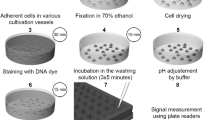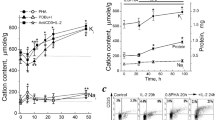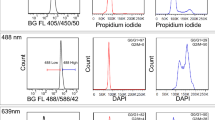Abstract
A CENTRAL issue in the study of both metazoan differentiation and the control of cellular activity is the validity or otherwise of the hypothesis1,2 that nonreplicating nuclei of a given higher organism contain a constant amount of DNA per haploid set of chromosomes. Differential elimination or increase of DNA has been demonstrated in dipteran polytene chromosomes3, and in the oocytes of Acheta and amphibia4, but apart from these possibly special cases the most studied apparent exception to the constancy rule is probably provided by mammalian leukocytes5–11. Most workers in this field have found the apparent DNA content of the relatively large nuclei of monocytes, as assessed by Feulgen cytophotometry, to be between 5% and 20% higher than that of the smaller, more darkly stained nuclei of lymphocytes and polymorphonuclear leukocytes. The consensus of opinion seems to be that the measured differences are probably due to nonstoichiometry of staining rather than to genuine differences in the amounts of DNA present. But work published to date has in general been performed without certain technical refinements which have recently become available, and we have now investigated the possibility that systematic cytophotometric errors may have been responsible for at least some of the reported differences between cell types.
This is a preview of subscription content, access via your institution
Access options
Subscribe to this journal
Receive 51 print issues and online access
$199.00 per year
only $3.90 per issue
Buy this article
- Purchase on Springer Link
- Instant access to full article PDF
Prices may be subject to local taxes which are calculated during checkout
Similar content being viewed by others
References
Boivin, A., Vendrely, R., and Vendrely, C., C.r. hebd. Séanc. Acad. Sci. Paris, 226, 1061 (1948).
Mirsky, A. E., and Ris, H., Nature, 163, 666 (1949).
Rudkin, G. T., Genetics, Suppl. 61, 1 (1969).
Lima-de-Faria, A., in Handbook of Molecular Cytology (edit. by Lima-de-Faria, A.), 277 (North-Holland, Amsterdam and London, 1969).
Hale, A. J., J. Path. Bact., 85, 311 (1963).
Garcia, A. M., Acta Histochem., 17, 230 (1964).
Deitch, D. A., Wagner, D., and Richart, R. M., J. Histochem. Cytochem., 16, 371 (1967).
Mayall, B. H., J. Histochem. Cytochem., 17, 249 (1969).
Sullivan, P. A., and Garcia, M., Acta Cytol., 14, 104 (1970).
Gottlieb-Rosenkrantz, P., and O'Brien, R., J. Histochem. Cytochem., 19, 232 (1971).
James, J., Acta Cytol., 17, 15 (1973).
Pearse, A. G. E., Histochemistry, (Churchill, London, 1960).
Goldstein, D. J., J. Microsc., 92, 1 (1970).
Goldstein, D. J., J. Microsc., 93, 15 (1971).
Author information
Authors and Affiliations
Rights and permissions
About this article
Cite this article
BEDI, K., GOLDSTEIN, D. Cytophotometric factors causing apparent differences between Feulgen DNA contents of different leukocyte types. Nature 251, 439–440 (1974). https://doi.org/10.1038/251439a0
Received:
Issue Date:
DOI: https://doi.org/10.1038/251439a0
This article is cited by
-
The effect of different fixatives on chromatin: Cytochemical and ultrastructural approaches
The Histochemical Journal (1981)
-
Cytophotometric evidence for cell ?transdifferentiation? in planarian regeneration
Wilhelm Roux's Archives of Developmental Biology (1980)
-
DNA contents, giemsa banding, and systematics inScilla bifolia, S. drunensis, andS. vindobonensis (Liliaceae)
Plant Systematics and Evolution (1978)
-
Method for the determination of mean densitometric profiles of chromosomes
Chromosoma (1976)
Comments
By submitting a comment you agree to abide by our Terms and Community Guidelines. If you find something abusive or that does not comply with our terms or guidelines please flag it as inappropriate.



